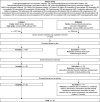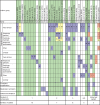Patient-Centered Interventions to Improve Adherence to Statins: A Narrative Synthesis of Systematically Identified Studies
- PMID: 27677773
- PMCID: PMC5047948
- DOI: 10.1007/s40265-016-0640-x
Patient-Centered Interventions to Improve Adherence to Statins: A Narrative Synthesis of Systematically Identified Studies
Abstract
Poor adherence to statins increases cardiovascular disease risk. We systematically identified 32 controlled studies that assessed patient-centered interventions designed to improve statin adherence. The limited number of studies and variation in study characteristics precluded strict quality criteria or meta-analysis. Cognitive education or behavioural counselling delivered face-to-face multiple times consistently improved statin adherence compared with control groups (7/8 and 3/3 studies, respectively). None of four studies using medication reminders and/or adherence feedback alone reported significantly improved statin adherence. Single interventions that improved statin adherence but were not conducted face-to-face included cognitive education in the form of genetic test results (two studies) and cognitive education via a website (one study). Similar mean adherence measures were reported for 17 intervention arms and were thus compared in a sub-analysis: 8 showed significantly improved statin adherence, but effect sizes were modest (+7 to +22 % points). In three of these studies, statin adherence improved despite already being high in the control group (82-89 vs. 57-69 % in the other studies). These three studies were the only studies in this sub-analysis to include cognitive education delivered face-to-face multiple times (plus other interventions). In summary, the most consistently effective interventions for improving adherence to statins have modest effects and are resource-intensive. Research is needed to determine whether modern communications, particularly mobile health platforms (recently shown to improve medication adherence in other chronic diseases), can replicate or even enhance the successful elements of these interventions while using less time and fewer resources.
Conflict of interest statement
Compliance with Ethical StandardsFundingThis study was funded by AstraZeneca Gothenburg, Mölndal, Sweden.Conflict of interestMagnus Jörntén-Karlsson, Staffan Berg and Matti Ahlqvist are employees of AstraZeneca Gothenburg, Mölndal, Sweden, which manufactures rosuvastatin. Stéphane Pintat and Michael Molloy-Bland are employees of Oxford PharmaGenesis Ltd, which receives funding from AstraZeneca.
Figures



Similar articles
-
The OPTIMIZE trial: Rationale and design of a randomized controlled trial of motivational enhancement therapy to improve adherence to statin medication.Contemp Clin Trials. 2016 Jul;49:47-56. doi: 10.1016/j.cct.2016.06.001. Epub 2016 Jun 6. Contemp Clin Trials. 2016. PMID: 27282119 Clinical Trial.
-
A text messaging intervention to promote medication adherence for patients with coronary heart disease: a randomized controlled trial.Patient Educ Couns. 2014 Feb;94(2):261-8. doi: 10.1016/j.pec.2013.10.027. Epub 2013 Nov 18. Patient Educ Couns. 2014. PMID: 24321403 Clinical Trial.
-
Effect of fixed dose combination treatment on adherence and risk factor control among patients at high risk of cardiovascular disease: randomised controlled trial in primary care.BMJ. 2014 May 27;348:g3318. doi: 10.1136/bmj.g3318. BMJ. 2014. PMID: 24868083 Clinical Trial.
-
Strategies to Improve Statin Medication Adherence Among Patients at Risk of Cardiovascular Disease Identified Through Electronic Health Records: A Literature Review.Stud Health Technol Inform. 2024 Jan 25;310:986-990. doi: 10.3233/SHTI231112. Stud Health Technol Inform. 2024. PMID: 38269962 Review.
-
Patient co-payment and adherence to statins: a review and case studies.Cardiovasc Drugs Ther. 2014 Feb;28(1):99-109. doi: 10.1007/s10557-013-6497-2. Cardiovasc Drugs Ther. 2014. PMID: 24150747 Review.
Cited by
-
Healthcare provider-led interventions to support medication adherence following ACS: a meta-analysis.Open Heart. 2017 Dec 22;4(2):e000685. doi: 10.1136/openhrt-2017-000685. eCollection 2017. Open Heart. 2017. PMID: 29344366 Free PMC article. Review.
-
Design and rationale for the "Me & My Heart" (eMocial) study: A randomized evaluation of a new smartphone-based support tool to increase therapy adherence of patients with acute coronary syndrome.Clin Cardiol. 2019 Nov;42(11):1054-1062. doi: 10.1002/clc.23254. Epub 2019 Sep 6. Clin Cardiol. 2019. PMID: 31490566 Free PMC article. Clinical Trial.
-
Barriers to and Facilitators of Technology in Cardiac Rehabilitation and Self-Management: Systematic Qualitative Grounded Theory Review.J Med Internet Res. 2020 Nov 11;22(11):e18025. doi: 10.2196/18025. J Med Internet Res. 2020. PMID: 33174847 Free PMC article.
-
Cost effectiveness of interventions to improve adherence to statin therapy in ASCVD patients in the United States.Patient Prefer Adherence. 2019 Aug 15;13:1375-1389. doi: 10.2147/PPA.S213258. eCollection 2019. Patient Prefer Adherence. 2019. PMID: 31496665 Free PMC article.
-
Optimizing Statin Therapy in Older Adults: A Systematic Review of Dosing, Titration, and Combination Strategies.Geroscience. 2025 Jul 16. doi: 10.1007/s11357-025-01772-w. Online ahead of print. Geroscience. 2025. PMID: 40665098 Review.
References
-
- World Health Organization. The World Health Report 2002. Reducing risks, promoting healthy life. 2002. http://www.who.int/whr/2002/en/. Accessed 5 May 2016.
-
- World Health Organization. Global Status Report on Noncommunicable Diseases. 2010. http://www.who.int/nmh/publications/ncd_report2010/en/. Accessed 5 May 2016.
-
- Baigent C, Blackwell L, Emberson J, Holland LE, Reith C, Bhala N, et al. Efficacy and safety of more intensive lowering of LDL cholesterol: a meta-analysis of data from 170,000 participants in 26 randomised trials. Lancet. 2010;376(9753):1670–1681. doi: 10.1016/S0140-6736(10)61350-5. - DOI - PMC - PubMed
Publication types
MeSH terms
Substances
LinkOut - more resources
Full Text Sources
Other Literature Sources
Medical

